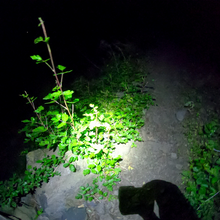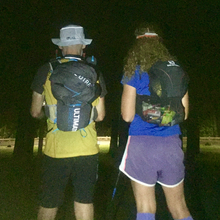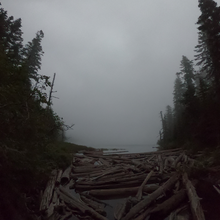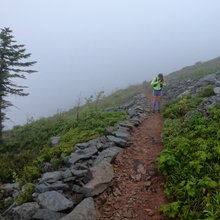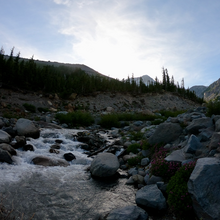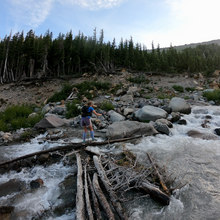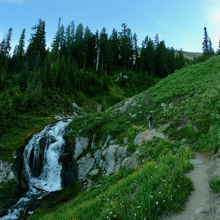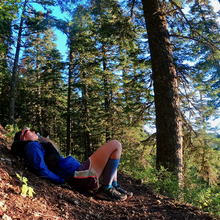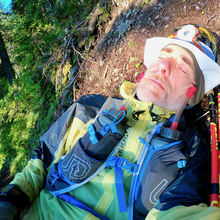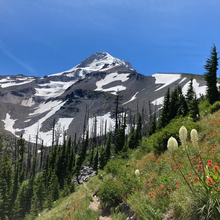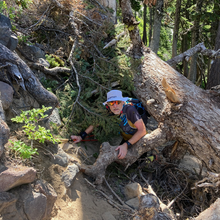Full report with more pics at https://www.christofteuscher.com/aagaa/report-102mi-unsupported-lollihood-fkt
Backstory
Neither of us had done the Timberline Trail and we felt a certain pressure to get it under our belts. However, the standard route sounded a little underwhelming. After all, anybody can drive up to 6,000 feet and spend a day ambling around a volcano. So we figured it would perhaps be more pure—and demanding—to start at sea level. As it turns out, there's a challenge for that: LolliHood. The route is part 1 of the Tamanawas 1-2-3-Hundred Challenge, which consists in circumnavigating three major volcanos—Mt. Hood, Mt. Adams, and Mt. St. Helens—from the Bridge of the Gods in Cascade Locks, OR.
Every beginning is hard
Christof's spreadsheets called for a 1am (sharp!) start on Friday morning. According to their (fallible) calculations, that would allow us to reach the Timberline Trail before noon and run the north portion of the route during the day, a section we'd not seen before.
We parked at the Bridge of the Gods trailhead, set off on time and in good spirits—only to be slowed for nearly 6 miles by an out-of-control poison oak (PO) carnival. Running would have been calamitous under any circumstances, but our bulging packs, laden with 102 miles worth of gear and food, made our ooze-avoidance a slow and miserable chore.
We did finally reach Benson plateau, and a relieving foggy breeze energized us. We made it to Wahtum lake (mile 14) more or less on schedule, filled our bottles, and continued.
Difficulty intensifies
The stretch to Lolo Pass (mile 30) was long, slow, and more notably: wetter than the Hoh in February. Along with dense fog and steady drizzle, we battled miles of soaked, overgrown vegetation and found ourselves as scratched and sopping as if we'd wandered into a carwash.
Somewhere during this section Megan spotted a strange animal in the middle of the trail. As she approached, it scurried under some beargrass, lingered, and gave us a minute to attempt identification. It look liked a rat—beady eyes, greasy fur—but without a tail. Christof grabbed his camera to snap a photo, but the mysterious mini-beast charged toward his leg. Christof screeched, recoiled, and nearly dropped his camera. Megan laughed until she choked. Luckily, the "rat" aborted its charge and disappeared into the brush. We decided that perhaps it was a rat with rabies and continued.
The sun peeked through the fog as we neared Lolo Pass. Our mood lightened, as did our steps, and we soon reached the intersection with Timberline Trail (mile 33). We were almost 30 minutes ahead of schedule. So far so good, it seemed. We looked forward to day’s warmth drying our shoes and socks...and to the miles gliding by.
On the Timberline Trail
The Timberline boost didn't last long. As we headed clockwise from Top Spur, the trail climbed gradually, then steeply, then gradually again. It seemed never to descend. The water crossings were challenging, and though we managed to never fall in or get wet, we slowed considerably each time. Twenty-minute miles remained elusive, and whenever we thought we'd found a rhythm, a blowdown materialized.
Somewhere between McNeil Point and Eliot, Christof felt his 47+years in the form of crippling nausea. As he violently evacuated 12 hours' worth of candied walnuts and expired crepes, Megan hypothesized that perhaps his recovery from the previous weekend's 75-mile Steens traverse was...not complete. Christof rolled his eyes, ate pudding from a baggy, and we both continued on.
When we finally reached Cloud Cap, we were 1 hour 45 minutes behind schedule. Clearly, things had not unfolded well. Megan unwrapped her feet and discovered heavily macerated skin. Christof ate some more candied walnuts, cursing all the while.
The journey—and the endless climbing—continued. More sand, more rocks, more river crossings...peeling skin, vomit, vomit...and soon it felt like the sun would set before we reached Timberline Lodge. And indeed it did.
Christof's stomach was surly, but Megan's feet raged. We finally stopped to tend to them: applied Desitin, tape, improvised a waterproof sock layer with a piece of an emergency blanket, cut holes into the shoe's insole to remove pressure from the worst points.
By the time we finally reached Timberline Lodge (mile 50) it was dark. We were 3 hours and 35 minutes behind schedule. Could we even finish? Would we have enough calories to get back to Cascade Locks? We talked about quitting several times, but not seriously. We were hurting and annoyed but not totally destroyed.
As we started our descent from Timberline Lodge, we heard a booming voice. We stopped. The voice boomed again. We shouted back. Whaaaat? As it turned out, a mysterious camper was calling out to us about the NEOWISE comet. "It's right there!" he was (apparently) bellowing. We turned off our headlamps and peered northwestward, and sure enough...there it was. As we gazed at its spectacular tail, we felt happier and continued on. (The comet went on to cheer us all night.)
Night two
One the way down to the Sandy River we were suddenly so exhausted that we decided to take a 5-minute trail nap. Neither of us checked the time, and we dozed for significantly longer. Still, once we rose we moved (what felt like) much more swiftly.
Somewhere near Paradise Park, Megan was about to leap across a small creek when suddenly she screamed. What had looked like a stable stepping rock turned out to be a second "rat" specimen enjoying a past-midnight bath. Do rats really do that? Megan was doubtful while Christof laughed until he choked.
The Sandy River crossing was straightforward, and soon we were climbing up to the PCT/Timberline Trail intersection. We thought we'd be there quickly, but we were predictably wrong. The switchbacks continued to materialize, but the intersection did not. Over an hour and several Fisherman's Friends later there it was, and we rested (thankfully) then marched on to Lolo Pass again. Now we only had about 33 miles left. Unfortunately, by this point we were almost 5 hours behind and a noon arrival at Cascade Locks, which he had envisioned, was out of the question.
Day two
The sun rose as we crossed Lolo Pass. It appeared as though it was going to be a great day again, and so to prepare ourselves, we took a short power nap (this time actually 5 minutes!) in a sunny spot. That did wonders! We felt revitalized and attacked the interminable stretch to Wahtum Lake. Thankfully, we did not fall even more behind our schedule. Megan ate waffle #21 and Christof another of his infamous dehydrated Ziplock meals.
We were both looking forward to the long descent into the Gorge but not looking forward to PO-decorated, 5+-mile section to Cascade Locks. At least were were on the same page?
The descent from the Benson Plateau was more painful and slow than we anticipated. Then came the last 5 miles, where we had to once again dodge the poison oak. "Dodge" perhaps improperly suggests we were moving at a fair clip; in fact, we were moving so slowly that we got passed by a PCT through-hiker.
About a mile before Cascade Locks Megan suddenly sat down, claiming her feet were so agonizing that she couldn't continue without some sort of first aid. An inspection revealed that the heavy maceration was now married with blisters and sand, and things were indeed very ugly. Still, it didn't take much deliberation to decide there was nothing we could do and that moving forward would probably be best. So we did.
The end
We reached Cascade Locks after 39 hours and 30 minutes, about 5 hours slower than anticipated. It was not disappointing, as that is how real adventures end—slower and more miserably than predicted.
"Rat" mystery solved
On the way home we Googled our "rats" and discovered that we had seen not one, but two elusive mountain beavers! Fitting indeed.
"Aplodontia rufa, commonly known as the mountain beaver, is the world's most primitive rodent: elusive, destructive and often mean. But it just loves living in the damp Pacific Northwest. [...] Some are very nice and passive. Some are angry and bite your hand off. Some, when released, will turn around, defiant, and lunge for her boots." [SeattleTimes]
We can definitely confirm the meanness and eagerness to attack.

